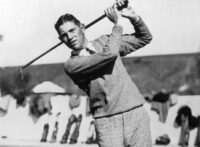Inductees
Horton Smith

May 22, 1908—October 15, 1963
Horton Smith was one of golf’s first boy wonders. In 1929, at the age of 21, he played a PGA Tour then in its infancy and won eight of 22 events as well as finishing second six times.
Smith and Paul Runyan were the tour’s top players during the Depression years. In all, Smith won 32 events and finished second 37 times. A tall, stylish man, he was a smooth swinger with a superb putting touch. Byron Nelson rated Smith the finest putter and chipper of his era, and long after he won his final tournament in 1941, Smith was much sought after by other players for putting advice.
Although Smith was never again quite as good as he had been in 1929, his greatest fame will always come from being the first winner of the Masters, then known as the Augusta National Invitational. In the fourth round, Craig Wood posted 285 early, so Smith knew he needed a 72 or better. After making a 20-foot birdie putt on the 17th hole, he knocked in a four-foot downhiller on the final green to win.
Smith won the event again in 1936. Two strokes behind Harry Cooper with five holes to go, he holed a 45-foot chip on the 68th, an eight-footer on the 69th, and a 16-footer on the 71st drenched by torrential rain. That year he also led the tour’s money list with $7,662.
Smith was born in Springfield, Mo., on May 22, 1908, and took up golf when he was 12. He grew to 6-1 1/2 and 163 pounds, and honed his game as an assistant pro at the Springfield C.C. When he joined the tour he earned the nickname the Missouri Rover by tirelessly traveling the country by car, train, and even boat to get to tournaments. Indeed, one year Smith suffered a fractured wrist when he hit it against a metal sign while stretching his arm out of a car driven by Joe Kirkwood.
Smith is believed to be the first professional to use a sand wedge in competition, a 23-ounce model invented by Texas cotton farmer Edward Kerr McClain. Smith used it in 1930 before it was banned for having a concave face. Smith also gave one to Bobby Jones, who used it to make a crucial birdie in the final round of the British Open at Hoylake on his way to the Grand Slam. Earlier in the year, Smith had won the Savannah Open to become the last man to defeat Jones in competition before his retirement.
According to Herbert Warren Wind, Smith was a student of the game who could be “overlogical, studious, finicky,” and probably experimented with his swing too much. Fairly early in his career, Smith’s swing lost its compact groove but soon became “the simplified and correct thing it had been.”
Smith didn’t smoke or drink. He was one of the rare professionals of his day who had attended college, the State Teacher’s College in Springfield. Later, showing organizational and public relations talent, Smith became chairman of the tour’s competition committee and eventually president of the PGA from 1952 to 1954.
Smith was chosen for five Ryder Cup teams and was never beaten. During his run of victories in 1929, he shot an all-time tour low 72-hole score of 245 at the par-64, 4,700-yard Catalina CC in California in 1928. He had scores of 63, 58, 61 and 63. He finished third at the U.S. Open in 1930 and 1940 and in the 1930 British Open. He passed away in 1963.
